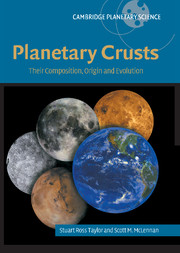Book contents
- Frontmatter
- Contents
- Preface
- Acknowledgments
- List of abbreviations
- Prologue
- 1 The planets: their formation and differentiation
- 2 A primary crust: the highland crust of the Moon
- 3 A secondary crust: the lunar maria
- 4 Mercury
- 5 Mars: early differentiation and planetary composition
- 6 Mars: crustal composition and evolution
- 7 Venus: a twin planet to Earth?
- 8 The oceanic crust of the Earth
- 9 The Hadean crust of the Earth
- 10 The Archean crust of the Earth
- 11 The Post-Archean continental crust
- 12 Composition and evolution of the continental crust
- 13 Crusts on minor bodies
- 14 Reflections: the elusive patterns of planetary crusts
- Indexes
- References
11 - The Post-Archean continental crust
Published online by Cambridge University Press: 22 October 2009
- Frontmatter
- Contents
- Preface
- Acknowledgments
- List of abbreviations
- Prologue
- 1 The planets: their formation and differentiation
- 2 A primary crust: the highland crust of the Moon
- 3 A secondary crust: the lunar maria
- 4 Mercury
- 5 Mars: early differentiation and planetary composition
- 6 Mars: crustal composition and evolution
- 7 Venus: a twin planet to Earth?
- 8 The oceanic crust of the Earth
- 9 The Hadean crust of the Earth
- 10 The Archean crust of the Earth
- 11 The Post-Archean continental crust
- 12 Composition and evolution of the continental crust
- 13 Crusts on minor bodies
- 14 Reflections: the elusive patterns of planetary crusts
- Indexes
- References
Summary
Possibly many may think that the deposition and consolidation of fine-grained mud must be a very simple matter and the results of little interest. However…. it is soon found to be so complex a question…that one might feel inclined to abandon the enquiry, were it not that so much of the history of our rocks appears to be written in this language.
(Henry C. Sorby)The continental crust of the Earth is so familiar to us that perhaps we underestimate its significance as a platform for human existence while at the same time overestimate its significance for understanding planetary crusts. Without such a haven above sea level, the later stages of evolution would have taken a very different course. If oceanic islands had formed the only dry land, birds rather than mammals might have become dominant as they did in Mauritius and New Zealand. However, the buoyant extensive continental crust has provided a useful platform for the land-based stages of evolution. After the extinction of the dinosaurs and much else 65 Myr ago, the way was cleared on the continental massifs for mammalian evolution to flourish. This led ultimately to the emergence of primates and to the appearance of many species of the genus Homo, ultimately enabling this account.
The Archean–Proterozoic transition
Following the Archean, that had lasted for 1500 Myr, the Proterozoic Eon continued for an even longer period (2000 Myr).
- Type
- Chapter
- Information
- Planetary CrustsTheir Composition, Origin and Evolution, pp. 275 - 300Publisher: Cambridge University PressPrint publication year: 2008

